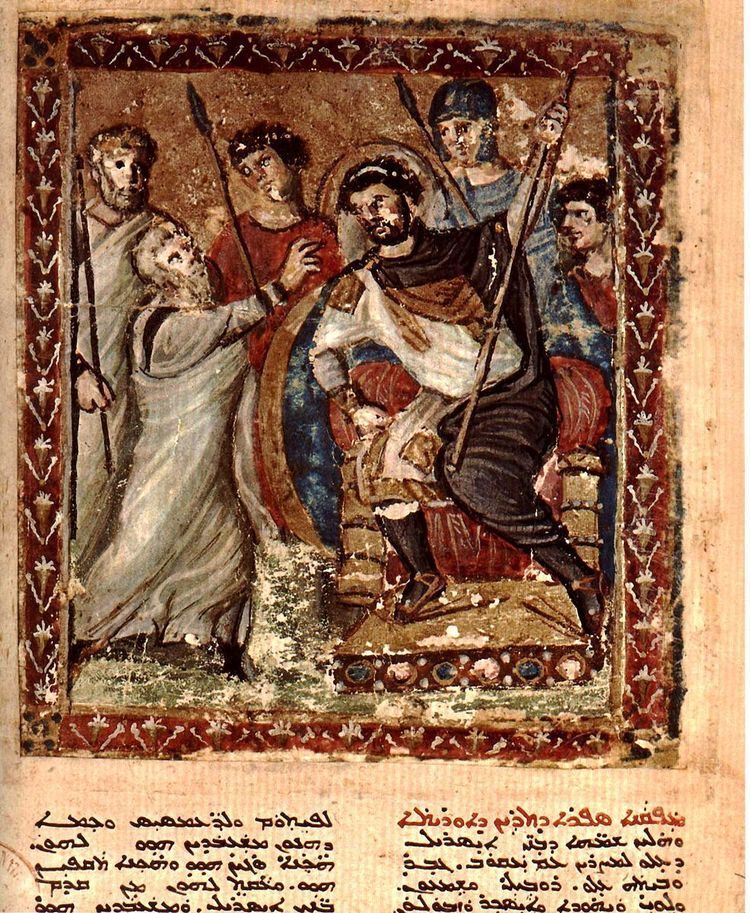 | ||
Syria played an important or even predominant role in the beginning of Christianity. Here is where the Gospel of Matthew, the Gospel of Luke, the Didache, Ignatiana, and the Gospel of Thomas were written. Syria was the country in which the Greek language intersected with the Syriac, which was closely related to the Aramaic dialect used by Jesus and the Apostles. That is why Syriac versions are highly esteemed by textual critics. Scholars have distinguished five or six different Syriac versions of all or part of the New Testament. It is possible that some translations have been lost. The majority of the manuscripts are now held in the British Library and in other European libraries. They came from countries like Lebanon, Egypt, Sinai, Mesopotamia, Armenia, Georgia, India, and even from China. This is good evidence for the great historical activity of the Syriac church.
Contents
Diatessaron
This is the earliest translation of the gospels into Syriac. Syriac is a Greek word for the language spoken by the Syrians. It was an Aramaic dialect spoken in Syria. The earliest translation of any New Testament text from Greek seems to have been the Diatessaron, a harmony of the four canonical gospels (perhaps with a non-extant fifth text) prepared about AD 170 by Tatian in Rome. Although no text of the Diatessaron survives, its foremost witness is a prose commentary on it by Ephrem the Syrian. Although there are many so-called manuscript witnesses to the Diatessaron, they all differ, and, ultimately only witness to the enduring popularity of such harmonies. Many medieval European harmonies draw on the Codex Fuldensis.
The Old Syriac version
The Old Syriac version of the four Gospels is preserved today in only two manuscripts, both with a large number of gaps. The Curetonian Gospels consist of fragments of the four Gospels. The text was brought in 1842 from the Nitrian Desert in Egypt, and is now held in the British Library. These fragments were examined by William Cureton and edited by him in 1858. The manuscript is dated paleographically to the 5th century. It is called Curetonian Syriac, and designated by Syrc.
The second manuscript is a palimpsest discovered by Agnes Smith Lewis in the Saint Catherine's Monastery in 1892 at Mount Sinai, called Sinaitic Syriac, and designated by Syrs. This version was known and cited by Ephrem the Syrian, It is a representative of the Western text-type.
These two manuscripts represent only Gospels. The text of Acts and the Pauline Epistles has not survived to the present. It is known only from citations made by Eastern fathers. The text of Acts was reconstructed by F. C. Conybeare, and the text of the Pauline Epistles by J. Molitor. They used Ephrem's commentaries.
In early February 2009, a third book was found in the possession of suspected antiquities smugglers in northern Cyprus. It appears to be a Syriac Bible dating from about 2000 years ago. The manuscript contains Bible excerpts written on vellum in gold lettering. One page has a drawing of a tree, and another eight lines of Syriac script. It was loosely strung together. Experts are divided over this manuscript, and whether it is an original or a fake.
Peshitta
The term Peshitta was used by Moses bar Kepha in 903 and means "simple" (in analogy to the Latin Vulgate). It is the oldest Syriac version which has survived to the present day in its entirety. It contains the entire Old Testament, most (?) of the deuterocanonical books, as well as 22 books of the New Testament, lacking the shorter Catholic Epistles (2-3 John, 2 Peter, Jude, as well as John 7:53-8:11). It was made in the beginning of the 5th century. Its authorship was ascribed to Rabbula, bishop of Edessa (411-435). The Syriac church still uses it to the present day.
More than 350 manuscripts survived, several of which date from the 5th and 6th centuries. In the Gospels it is closer to the Byzantine text-type, but in Acts to the Western text-type. It is designated by Syrp.
The earliest manuscript of the Peshitta is a Pentateuch dated AD 464. There are two New Testament manuscripts of the 5th century (Codex Phillipps 1388).
Later Syriac versions
The Philoxenian was probably produced in 508 for Philoxenus, Bishop of Mabbug in eastern Syria. This translation contains the five books not found in the Peshitta: 2 Peter, 2 John, 3 John, Jude, and the Apocalypse. This translation survived only in short fragments. It is designated by syrph. Harclensis is designated by syrh. It is represented by some 35 manuscripts dating from the 7th century and later; they show kinship with the Western text-type.
According to some scholars the Philoxenian and Harclensis are only recensions of Peshitta, but according to others they are independent new translations.
About AD 500 a Palestinian Syriac version was made in the Palestinian dialect. It contains 2 Peter, 2-3 John, Jude, and Apocalypse. It is a representative of the Caesarean text-type and is a unique translation different from any other which was made into Syriac. These are among the manuscripts used by John Gwynn in 1893 to complete his edition of the Catholic Epistles.
In 1892 Agnes Smith Lewis discovered the manuscript of the Palestinian Syriac lectionary in the library of Saint Catherine's Monastery on Mount Sinai. It is designated by Syrpal.
